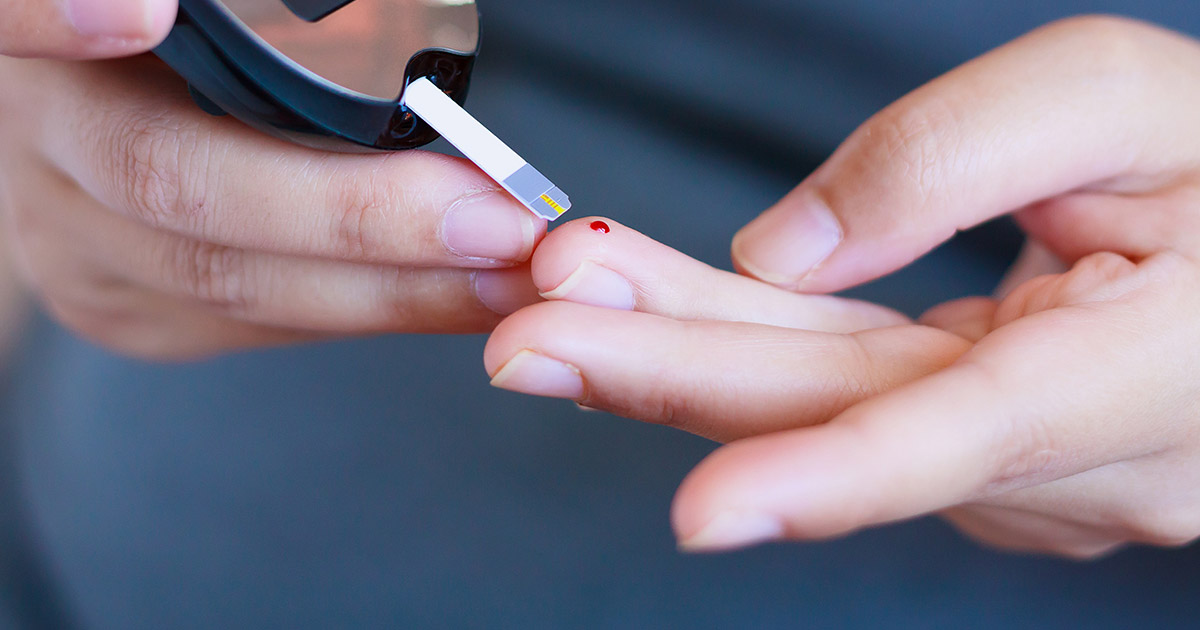Measurement of blood glucose and ketosis levels*
dr. reinwald metabolic regulation® – Part 7
The measurement of the ketosis level in the blood, in this case of the ketone body ß-hydroxy-byturate (BHB), is, in contrast to blood sugar measurement, not yet so widespread. Accordingly, the so-called ketosticks are much more expensive: they are purple at Abbott. For blood glucose measurement, the measuring strips are blue – see the picture below. But the investment is worth it… read why below.
Freestyle Precision and Ketosticks
The device itself is available in two versions: one with the usual German measurement of the BG in mg/dl and one with the international measurement in mmol/L, in which the ketosis level is also measured. So if you are used to observing your BG in mg/dl, you should pay attention to this when buying the device if you do not want to constantly convert. With time, however, one also gets used to the values in mmol/L, as is usual for the ketosis level. But of course with other conductance values – so watch out!
The much cheaper urine sticks for ketosis measurement only give approximate values, because ketone bodies are only found in the urine when the body is in ketosis metabolism, but the ketone bodies cannot yet be utilised for energy production and are therefore excreted in the urine. If they can be found in the urine, the enzymes required for energy utilisation are still missing, above all beta-hydroxy-methylglutaryl-CoA (HMG-CoA), which, by the way, is also important for the cholesterol metabolism, which is so important. This means that if the ketone metabolism functions well and runs enzymatically correctly (ketolysis ability), only very few ketone bodies end up in the urine and one can sensibly determine the ketosis level only in the blood.
How to measure “correctly
For the measurement routine I recommend the following rhythm (measurement duration for the ketosis level 5 days in a row, then can be reduced to a 3-5 day rhythm):
- Blood glucose in the morning on an empty stomach and in the evening before dinner (exception: diabetics, who should check more closely and also measure the postprandial values, i.e. 1.5-2 hours after eating).
- Ketosis level after three days at the earliest, like BG in the morning fasting and in the evening before dinner.
How does measuring work with Freestyle?
- Remove the test strip from the cover and push the chip-marked area into the insertion opening of the device.
- The device will then start automatically
- Follow the instructions of the device or the display.
- Prick the side of the fingertip with a lancet and squeeze out a thick drop of blood (do not press or squeeze too hard, it is better to touch it and hold it down or, if the amount of blood is not sufficient, prick again with a greater depth of prick – note: a slightly larger amount of blood is required for the ketone measurement than for the BG measurement.
- If you use the lancet instead of the small pricker, you can adjust the pricking depth there.
- Hold the blood drop against the front part of the test strip until enough blood is drawn in and wait. As soon as the amount of blood is sufficient, this is indicated on the display by the three moving side strips. When the third strip fills up, the measurement starts automatically.
- Note: with the test strips, please always make sure that there is a sufficient amount of blood before you put your finger on it, as readjustment is no longer possible. The test strip is unusable if the blood is insufficiently saturated, as the device will not accept a second or subsequent measurement on the same strip.
Initially, only the blood glucose level should be measured in order to save the expensive keto sticks, and this should be done in the morning on an empty stomach and in the evening before dinner, i.e. after a longer food abstinence of at least six hours. After the initial 5-day measurement, it is no longer necessary to measure the blood sugar and ketosis levels daily (after the first 3 days for a total), unless it is very important to know the current daily level, as in the case of cancer, for example.
Measurement in diabetes
Diabetics who take medication to lower their blood sugar level and people with a prediabetic metabolic condition, which in my view already includes those who have fasting blood sugar values of >90 mg/dl or >5mmol/L, should definitely be monitored closely, as our ketogenic nutrition programme has, from experience and naturally desired, resulted in a strong lowering of the blood sugar level. In order to avoid hypoglycaemia when the “substitute fuel” (fatty acids and ketone bodies) is not yet available or the ketolysis ability (process of ketoadaptation) is not yet present, it is important to monitor the blood glucose level more closely for the correct dosage of medication. A low blood sugar level once ketosis and ketolysis ability have been achieved, i.e. in the context of efficient utilisation of the ketone bodies together with the fatty acids as the main energy suppliers, is not a problem. Not even for the brain, which is supposedly exclusively dependent on sugar. On the contrary! That the brain is exclusively dependent on sugar is one of those old wives’ tales of orthodox medicine that persists at least as stubbornly as the naive belief in the sterility of the blood or the placenta. Studies as early as the 1960s to 1980s were able to show that keto-adapted individuals tolerate a BG level at least as extremely low as that of infants in ketosis on a normal mother’s milk diet.
Only after a few days of initial fasting or my phase 1 or 2 diet – in the latter case it takes a little longer – should you start measuring the ketosis levels with the ketosis sticks via the blood. If you want to save money, one ketosis level measurement in the evening before dinner should be enough. In the morning, the ketosis level is usually lower than in the evening due to the activities of gluconeogenesis during the night, i.e. after a certain food abstinence and without the increased gluconeogenesis activity of our organism during the night. In the morning, the ketosis level is usually between 0.5 and 1.0 mmol/L. In the evening, it should be between 1.5 and 1.0 mmol/L. In the evening, it should be between 1.5-2.5 in normal cases, i.e. in nutritional ketosis. In younger people, ketosis is usually reached more quickly than in older people.
With increased exercise performance through sport, the blood glucose level is usually elevated after sport because the organism releases more lactic acid due to the increased muscle activity and can thus obtain additional glucose. The body can form additional glucose from a total of three non-carbohydrate precursors: glucogenic amino acids from food proteins, lactate (lactic acid) and glycerol (fatty acids). So basically, it is completely independent of an external sugar supply. These considerations are largely negligible when training below the lactate threshold. In this case, the body does not get into oxygen starvation, and accordingly it does not need to further metabolise the lactate produced via lactic acid fermentation for energy production. The so-called ex-post-excercise ketosis level can reach up to 3.0 mmol/L and more. It occurs when the remaining lactic acid from the sporting activity has been consumed.

